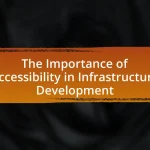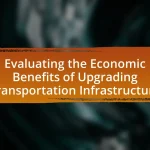Regional transportation authorities face significant funding challenges, including reliance on unstable revenue sources, competition for limited public funds, and rising operational costs. Economic factors, such as growth and downturns, directly influence funding availability, while public policy and legislative changes shape financial allocations. Successful strategies to address these challenges include diversifying funding sources, engaging in public-private partnerships, and implementing innovative financing mechanisms. Additionally, public support and transparency are crucial for securing funding, as they enhance trust and community involvement in transportation initiatives. The article provides a comprehensive analysis of these issues, highlighting the implications for regional transportation authorities and potential solutions to improve funding strategies.

What are the key funding challenges faced by regional transportation authorities?
Regional transportation authorities face several key funding challenges, primarily including reliance on unstable revenue sources, competition for limited public funds, and increasing operational costs. These authorities often depend on sales taxes and state funding, which can fluctuate with economic conditions, leading to unpredictable revenue streams. Additionally, they compete with other public services for budget allocations, making it difficult to secure adequate funding for transportation projects. Furthermore, rising costs associated with maintenance, infrastructure improvements, and technology upgrades place additional financial strain on these authorities, complicating their ability to deliver reliable transportation services.
How do economic factors influence funding for regional transportation authorities?
Economic factors significantly influence funding for regional transportation authorities by determining the availability of financial resources and the prioritization of transportation projects. Economic growth typically leads to increased tax revenues, which can enhance funding for transportation initiatives, while economic downturns often result in budget cuts and reduced funding. For instance, during the 2008 financial crisis, many regional transportation authorities faced severe funding shortfalls due to decreased sales tax revenues and state funding, highlighting the direct correlation between economic conditions and transportation funding. Additionally, factors such as unemployment rates, inflation, and overall economic stability impact public and private investment in transportation infrastructure, further affecting the financial landscape for regional authorities.
What role does local economic growth play in transportation funding?
Local economic growth significantly influences transportation funding by increasing tax revenues that can be allocated to infrastructure projects. As local economies expand, they generate higher sales, property, and income taxes, which provide essential financial resources for transportation initiatives. For instance, a study by the American Public Transportation Association found that every $1 invested in public transportation generates approximately $4 in economic returns, highlighting the direct correlation between economic activity and funding availability. This relationship underscores the importance of fostering local economic development to enhance transportation funding and improve regional infrastructure.
How do fluctuations in state and federal funding impact regional authorities?
Fluctuations in state and federal funding significantly impact regional authorities by altering their financial stability and operational capacity. When funding decreases, regional authorities often face budget shortfalls, leading to service reductions, project delays, and increased difficulty in maintaining infrastructure. For instance, a 2020 report from the American Public Transportation Association indicated that a 20% reduction in federal funding could result in a loss of over 40,000 jobs and a decrease in service levels across multiple regions. Conversely, increases in funding can enhance service offerings, expand infrastructure projects, and improve overall transportation efficiency, as seen in regions that received additional federal grants for transit improvements. Thus, the variability in funding directly influences the effectiveness and sustainability of regional transportation authorities.
What are the implications of public policy on transportation funding?
Public policy significantly influences transportation funding by determining allocation priorities, funding sources, and regulatory frameworks. For instance, policies that prioritize public transit can lead to increased federal and state funding for regional transportation authorities, as seen in the Fixing America’s Surface Transportation (FAST) Act, which allocated $305 billion for transportation over five years, emphasizing public transit investment. Additionally, public policy can shape funding mechanisms, such as grants and tax incentives, which directly affect the financial resources available for transportation projects. These implications highlight the critical role of policy decisions in shaping the financial landscape for transportation infrastructure and services.
How do legislative changes affect funding allocations?
Legislative changes directly influence funding allocations by altering the legal framework and priorities that govern financial resources. For instance, when new laws are enacted that prioritize infrastructure development, regional transportation authorities may receive increased funding to support projects aligned with those legislative goals. Historical examples include the Fixing America’s Surface Transportation (FAST) Act, which provided dedicated funding for transportation projects, demonstrating how legislative action can lead to specific financial commitments. Additionally, changes in federal or state funding formulas can redistribute resources among various transportation projects, impacting the overall budget available to regional authorities.
What policies have been successful in addressing funding challenges?
Successful policies addressing funding challenges for regional transportation authorities include dedicated funding sources, public-private partnerships, and innovative financing mechanisms. Dedicated funding sources, such as sales taxes or vehicle registration fees, provide stable revenue streams; for instance, California’s Proposition 1B allocated $19.9 billion for transportation infrastructure, significantly enhancing funding stability. Public-private partnerships leverage private investment for public projects, exemplified by the I-495 Capital Beltway project in Virginia, which utilized private funding to expand capacity. Innovative financing mechanisms, like value capture, allow authorities to recoup costs from increased property values near transit projects, as seen in the Denver FasTracks program, which generated substantial revenue through this approach. These policies have proven effective in mitigating funding challenges faced by regional transportation authorities.
Why is public support crucial for funding regional transportation initiatives?
Public support is crucial for funding regional transportation initiatives because it directly influences the allocation of government resources and the success of funding measures. When the public demonstrates strong support for transportation projects, policymakers are more likely to prioritize and approve funding, as seen in successful ballot measures where public backing led to increased investment in infrastructure. For instance, a study by the American Public Transportation Association found that regions with high public support for transit initiatives often secure funding through local taxes or state grants, highlighting the correlation between community endorsement and financial backing.
How can regional transportation authorities engage the public for support?
Regional transportation authorities can engage the public for support by implementing transparent communication strategies and actively involving community members in decision-making processes. For instance, conducting public forums and surveys allows authorities to gather input and address concerns, fostering a sense of ownership among residents. Research indicates that when stakeholders feel their voices are heard, support for funding initiatives increases; a study by the American Public Transportation Association found that 70% of respondents support transit funding when they are involved in planning.
What strategies can be employed to raise awareness about funding needs?
To raise awareness about funding needs for regional transportation authorities, targeted communication strategies should be employed. These strategies include engaging stakeholders through public forums, utilizing social media campaigns to reach a broader audience, and collaborating with local businesses and community organizations to amplify the message. For instance, a study by the American Public Transportation Association found that public engagement initiatives can increase community support for funding by up to 30%. Additionally, creating informative materials that clearly outline the benefits of funding for transportation projects can help educate the public and decision-makers about the importance of financial support.

What alternative funding sources are available for regional transportation authorities?
Alternative funding sources available for regional transportation authorities include public-private partnerships (PPPs), grants from federal and state governments, local sales taxes, and dedicated funding from vehicle registration fees. Public-private partnerships allow for shared investment and risk in transportation projects, enhancing financial resources. Federal and state grants, such as those from the Federal Transit Administration, provide significant financial support for infrastructure improvements. Local sales taxes can be implemented to generate revenue specifically for transportation projects, while vehicle registration fees can be earmarked for maintenance and development of transportation systems. These funding mechanisms are essential for addressing the financial challenges faced by regional transportation authorities.
How can public-private partnerships enhance funding opportunities?
Public-private partnerships (PPPs) can enhance funding opportunities by leveraging private sector investment to supplement public funding for infrastructure projects. These partnerships allow regional transportation authorities to access additional financial resources, expertise, and innovative solutions that may not be available through traditional public funding alone. For instance, a study by the World Bank indicates that PPPs can reduce the financial burden on public budgets while accelerating project delivery, as seen in successful transportation projects in countries like Australia and Canada, where private investment has significantly improved infrastructure development timelines and efficiency.
What are the benefits and challenges of public-private partnerships?
Public-private partnerships (PPPs) offer benefits such as improved efficiency and access to private sector expertise, while challenges include potential misalignment of goals and complex contractual arrangements. The efficiency of PPPs can lead to cost savings and faster project delivery, as evidenced by the successful implementation of infrastructure projects like the London Underground’s public-private partnership, which improved service quality. However, challenges arise when public and private entities have differing objectives, which can complicate project execution and lead to disputes, as seen in various transportation projects where contractual complexities delayed outcomes.
How have successful partnerships been structured in other regions?
Successful partnerships in other regions have been structured through collaborative frameworks that involve public-private partnerships (PPPs), shared governance models, and stakeholder engagement. For instance, in Europe, the Netherlands has effectively utilized PPPs to fund transportation infrastructure, allowing private entities to share the financial burden while ensuring public accountability. This model has led to the successful completion of projects like the High Speed Rail, which was financed through a combination of government funds and private investments, demonstrating a balanced risk-sharing approach. Additionally, in Australia, regional transportation authorities have engaged local communities and businesses in decision-making processes, fostering a sense of ownership and ensuring that projects meet local needs. This participatory approach has been crucial in securing funding and support for various transportation initiatives, highlighting the importance of collaboration across sectors.
What role do grants and federal programs play in funding transportation projects?
Grants and federal programs are crucial in funding transportation projects by providing financial resources that support infrastructure development and maintenance. These funding mechanisms enable regional transportation authorities to undertake large-scale projects that might otherwise be financially unfeasible. For instance, the Federal Transit Administration allocates billions annually through programs like the Capital Investment Grants program, which specifically funds new transit projects and improvements. In fiscal year 2021, the federal government allocated approximately $13.5 billion for public transportation, demonstrating the significant role these funds play in enhancing transportation systems across the country.
Which federal programs are most beneficial for regional transportation authorities?
The federal programs most beneficial for regional transportation authorities include the Federal Transit Administration’s (FTA) Urbanized Area Formula Grants and the FTA’s Capital Investment Grants. These programs provide essential funding for public transit systems, enabling regional authorities to improve infrastructure and expand services. For instance, the Urbanized Area Formula Grants allocate approximately $4.5 billion annually to support public transportation in urban areas, while the Capital Investment Grants program has funded major transit projects, contributing to economic development and enhanced mobility.
How can authorities effectively apply for and manage grants?
Authorities can effectively apply for and manage grants by implementing a structured approach that includes thorough research, strategic planning, and diligent monitoring. First, authorities should identify relevant grant opportunities that align with their transportation goals, utilizing resources like Grants.gov and state funding websites. Next, they must develop a comprehensive grant proposal that clearly outlines project objectives, budget, and expected outcomes, ensuring compliance with the specific requirements of the funding agency.
Once awarded, effective management involves establishing a dedicated team to oversee grant implementation, maintaining accurate financial records, and adhering to reporting deadlines. Regular communication with the funding agency is crucial for addressing any issues and ensuring compliance. According to the National Association of Development Organizations, successful grant management can lead to improved project outcomes and increased funding opportunities in the future.
What innovative financing mechanisms can be utilized?
Innovative financing mechanisms that can be utilized include value capture financing, public-private partnerships (PPPs), and social impact bonds. Value capture financing allows regional transportation authorities to capture the increase in property values resulting from transportation improvements, thereby generating revenue for future projects. Public-private partnerships enable collaboration between government entities and private firms, leveraging private investment for infrastructure development while sharing risks and rewards. Social impact bonds provide a way to fund social programs through private investment, where returns are based on the achievement of specific outcomes, thus aligning financial incentives with public benefits. These mechanisms have been successfully implemented in various regions, demonstrating their effectiveness in addressing funding challenges for transportation authorities.
How do value capture and congestion pricing work as funding tools?
Value capture and congestion pricing serve as effective funding tools by generating revenue from the increased value of properties and by charging users for road access during peak times, respectively. Value capture involves taxing the increased property values that result from public infrastructure investments, such as transit projects, which can provide significant funding for future developments; for instance, cities like San Francisco have successfully utilized this method to finance transit improvements. Congestion pricing, on the other hand, charges drivers a fee to use certain roads during high-traffic periods, thereby reducing congestion and generating funds that can be reinvested in transportation infrastructure; New York City’s congestion pricing plan is projected to raise over $1 billion annually for public transit. Both methods not only enhance funding but also promote more efficient use of transportation resources.
What are the potential risks and rewards of using innovative financing?
Innovative financing presents both significant rewards and notable risks for regional transportation authorities. The rewards include increased access to capital, enabling the funding of large-scale infrastructure projects that may otherwise be unattainable through traditional financing methods. For instance, public-private partnerships (PPPs) can leverage private investment, reducing the financial burden on public entities while accelerating project delivery. Additionally, innovative financing mechanisms, such as value capture and social impact bonds, can align funding with project outcomes, enhancing accountability and efficiency.
Conversely, the risks associated with innovative financing include potential financial instability and the complexity of agreements that may lead to misalignment of interests between public and private stakeholders. For example, reliance on market conditions can expose projects to fluctuations that jeopardize funding availability. Furthermore, the intricate nature of innovative financing structures can result in legal and regulatory challenges, complicating project execution and increasing costs. These factors necessitate careful consideration and strategic planning to mitigate risks while maximizing the benefits of innovative financing in regional transportation projects.

How can regional transportation authorities improve their funding strategies?
Regional transportation authorities can improve their funding strategies by diversifying revenue sources, such as implementing value capture financing, increasing public-private partnerships, and exploring innovative funding mechanisms like congestion pricing. Diversifying revenue sources allows authorities to reduce reliance on traditional funding methods, which can be unstable. For instance, value capture financing has been successfully used in cities like San Francisco, where increased property values near transit stations have generated additional tax revenue to fund transportation projects. Additionally, public-private partnerships can leverage private investment for infrastructure improvements, as seen in projects like the Denver FasTracks, which expanded transit services through collaborative funding. Lastly, congestion pricing, implemented in cities like London, has shown to effectively manage demand while generating significant revenue for public transit systems.
What best practices can be adopted for effective funding management?
Effective funding management can be achieved through the implementation of transparent budgeting, regular financial audits, and stakeholder engagement. Transparent budgeting allows for clear visibility into financial allocations, ensuring that funds are used efficiently and effectively. Regular financial audits help identify discrepancies and improve accountability, as evidenced by studies showing that organizations with frequent audits report better financial health. Engaging stakeholders, including community members and local governments, fosters trust and collaboration, which is crucial for securing ongoing funding and support. These practices collectively enhance the financial stability and operational efficiency of regional transportation authorities.
How can data-driven decision-making enhance funding strategies?
Data-driven decision-making enhances funding strategies by enabling regional transportation authorities to allocate resources more efficiently based on empirical evidence and predictive analytics. By analyzing historical data on ridership patterns, operational costs, and demographic trends, authorities can identify the most effective funding allocations and prioritize projects that yield the highest return on investment. For instance, a study by the American Public Transportation Association found that data-driven approaches can lead to a 20% increase in funding efficiency by aligning investments with actual community needs and usage patterns. This targeted approach not only maximizes the impact of available funds but also improves transparency and accountability, fostering greater public trust and support for funding initiatives.
What role does transparency play in gaining public trust and support?
Transparency is crucial in gaining public trust and support, particularly for regional transportation authorities. When these authorities openly share information about funding, decision-making processes, and project outcomes, they foster accountability and credibility. Research indicates that communities are more likely to support initiatives when they understand how funds are allocated and the rationale behind decisions. For instance, a study by the American Public Transportation Association found that transparency in budget reporting significantly correlates with increased public approval ratings for transportation projects. This demonstrates that clear communication and openness not only enhance trust but also encourage community engagement and support for funding initiatives.
How can regional transportation authorities advocate for better funding?
Regional transportation authorities can advocate for better funding by actively engaging with policymakers and demonstrating the economic and social benefits of robust transportation systems. They can present data showing that every dollar invested in public transportation generates approximately four dollars in economic returns, as reported by the American Public Transportation Association. Additionally, authorities can build coalitions with community stakeholders to amplify their message, highlighting how improved funding can enhance mobility, reduce congestion, and promote environmental sustainability. By utilizing case studies and success stories from other regions that have successfully secured funding, they can effectively illustrate the potential positive impacts of increased investment in transportation infrastructure.
What strategies can be employed to influence policy changes?
To influence policy changes, stakeholders can employ strategies such as advocacy, coalition building, and data-driven lobbying. Advocacy involves actively promoting specific policy positions to decision-makers, while coalition building brings together diverse groups to amplify their collective voice and increase influence. Data-driven lobbying utilizes empirical evidence and research to support policy proposals, demonstrating their feasibility and potential impact. For instance, studies have shown that regions with strong advocacy networks and data-backed proposals are more likely to secure funding and support for transportation initiatives, as evidenced by successful campaigns in cities like Seattle and Los Angeles, where collaborative efforts led to significant policy advancements.
How can collaboration with stakeholders improve funding outcomes?
Collaboration with stakeholders can significantly improve funding outcomes by enhancing resource mobilization and aligning interests. When regional transportation authorities engage with stakeholders such as local governments, community organizations, and private sector partners, they can pool financial resources, share expertise, and create a unified vision that attracts funding. For instance, a study by the Transportation Research Board found that collaborative approaches in project planning led to a 30% increase in funding success rates for transportation initiatives. This demonstrates that effective stakeholder collaboration not only broadens the funding base but also fosters trust and commitment, making projects more appealing to potential funders.
What are the key takeaways for addressing funding challenges in regional transportation?
Key takeaways for addressing funding challenges in regional transportation include diversifying funding sources, enhancing public-private partnerships, and implementing innovative financing mechanisms. Diversifying funding sources, such as federal grants, state allocations, and local taxes, can reduce reliance on a single revenue stream, thereby increasing financial stability. Public-private partnerships can leverage private investment for infrastructure projects, as evidenced by successful collaborations in cities like Los Angeles, which have improved transit systems while sharing costs. Innovative financing mechanisms, such as value capture and congestion pricing, can generate additional revenue by aligning funding with usage, as demonstrated in cities like San Francisco, where congestion pricing has led to increased funding for public transit improvements.


